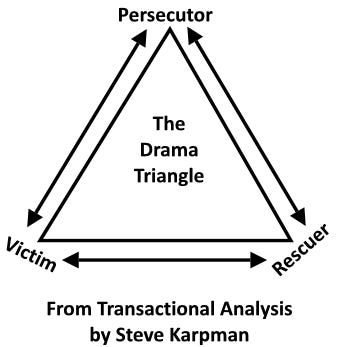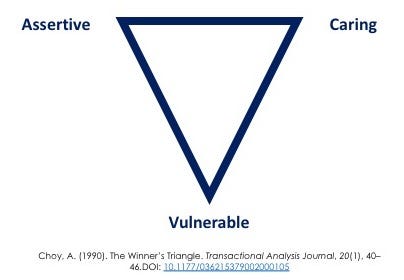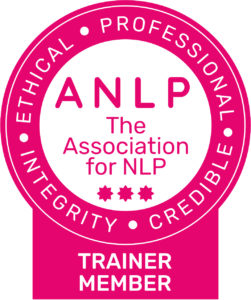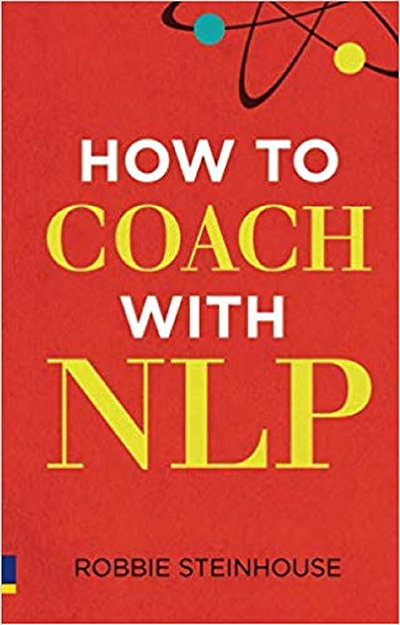How NLP Can Help With Your Relationships — The Drama Triangle

The pandemic is putting a strain on many people, personally and in their close relationships. Between the unprecedented period of proximity for many families, and the underlying atmosphere of stress, uncertainty and fear on the global stage, this is understandable.
I believe that good communication, as always, is the key. Whether it’s a niggling annoyance at the way your partner stacks the dishwasher, or being able to ask for space from your partner and kids, without fear of emotional repercussions, it is more important now than ever to communicate one’s feelings and needs.
But good communication is built on a solid foundation – a calm and receptive state of mind. Without this, it is easy to forego communication altogether, and express oneself through anger, passive-aggression or emotional withdrawal.
This type of perspective can often be achieved by recognising and naming one’s current state. It is much harder to be unreasonable, once you have recognised that you are being unreasonable.
This is why I believe that psychological education is so important. The more vocabulary and tools we have for recognising our psychological blindspots, the more we can influence our reality.
One such tool is The Drama Triangle — a social model designed by Stephen Karpman, a student of the eminent psychologist and founder of Transactional Analysis, Eric Berne.
What is the Drama Triangle?

It describes the way in which we see ourselves and other people, especially when we are feeling triggered.
Below are general descriptions of each role on the triangle, though the specifics will vary from person to person, and between situations:
The Victim feels persecuted by others and sees their place in the world through a lens of powerlessness. In general, they see their problems as unsolvable. They blame others (The Persecutor) for those problems, and look to others (The Rescuer) for solutions. In other words, they deny themselves the power to change their circumstances.
The Persecutor is often critical of others, but rarely self-critical. They can be controlling, rigid and authoritative. They often express themselves through anger or aggression, whether passive or active.
The Rescuer tries to solve other people’s problems, but often neglects their own. This personality also has a darker side — the Rescuer needs to feel needed, so often keeps the Victim in a state of dependency in order to achieve this aim, rather than helping them to develop the skills, in order to help themselves.
It is important to note that most people play all three of these roles at one point or another, and to different degrees. However, the drama arises from the way in which people cycle from one role to the other, going from Victim to Persecutor to Rescuer, while their co-dancer moves in the opposite direction. As with most cycles, it can become difficult to break free of this.
The Drama Triangle in Action
So how does apply to situations in reality?
In the above example of the partner who wants to take some space for themselves, but worries about the reaction(s) of their co-parent and children, for example, the partner is positioning themselves as the Victim, and their co-parent and kids as the Persecutors.
Another example is of the whole triangle at play. Two siblings are fighting. The mother intervenes, to tell one child (Sibling A) to cut it out, and apologise, while calming and reassuring the second child (Sibling B), and asking for or allowing their side of the story to be told. In this instance, the mother is positioning Sibling A as the Persecutor, Sibling B as the Victim, and themselves as the Rescuer.
When it comes to family units, individuals tend to get stuck with their Drama Triangle roles. This tends to happen because, if a person is positioned as the Persecutor, for example, irrespective of what they do or how they behave, eventually they will give up and just accept this role instead. In some ways, therefore, by treating someone as a Persecutor (or Victim or Rescuer), we actually force them to embody this role.
How to Change the Drama Triangle
Recognising that you are in a Drama Triangle is the first step to changing the dynamic.
Instead, you could choose to understand the dynamic that you are entering into and recognise the narratives that you are telling yourself (“I’m so angry at them for making me feel like X” or “There’s nothing I can do about this!”). Then make a mental decision not to engage with the narrative and, if possible, take some physical space from the situation.
This creates the mental space that you need for something to be done differently, and for the situation or dynamics which give rise to the Drama Triangle to be changed in a longer-term way.
So I will run through the above examples again, but this time through the lens of change:
- The worried partner could take the space that they need, recognising that the guilt they feel around this, and their concerns regarding their co-parent’s and children’s reactions, are an imagined fact. They could also recognise that they are positioning themselves as the Victim and, once they feel sufficiently able to, take matters into their own hands instead. This could take the form of agreeing with their partner how they will split the role of parenting fairly, while also arranging to have time by themselves, and agreeing that neither party will hold this against the other.
- The mother who is trying to resolve the fight could recognise that she has entered into a Drama Triangle, and is positioning herself as the Rescuer. She could then ask herself what emotional need she is meeting through this. As discussed in my previous post, negative behaviour is often founded on a positive intention. So, for example, the mother could be avoiding feeling unwanted or not needed. Having recognised this, she could then ask herself whether there is a more positive and constructive way in which she could meet this need instead i.e. by contributing to the community or working on her own projects.
The Winner’s Triangle
Beyond this, Acey Choy developed a new model of behaviour, called The Winner’s Triangle, first presented in The Transactional Analysis Journal in 1990.

Choy focuses on the positive elements of each of the roles. For example, underlying the Victim is the skill of Vulnerability. The Rescuer is caring, albeit misguided. The Prosecutor is Assertive, which can be valuable in many situations.
To bring out these, more positive elements of the three roles, Choy advises that individuals actively change their behaviour and responses.
For example:
The Victim can:
- Recognise and face their fears;
- Think about what they can do in any given situation;
- Learn new skills and improve their ability to make decisions; and
- Think about their goals. Plan how to achieve them and then act.
The Persecutor can:
- Recognise when they are blaming others and take responsibility for their actions and feelings;
- Learn to negotiate instead of being rigid;
- Learn how to communicate their needs; and
- Give feedback without being critical.
The Rescuer can:
- Find out the motive behind their helpfulness — is it meeting a personal need? If so, they can try to come up with another way to meet this need;
- Work with the intention of helping others to help themselves; and
- Learn to recognise when their help is actually making matters worse in the long term.
Conclusion
Untangling the Drama Triangle can be the work of many lifetimes. But by learning to recognise when we are in the midst of a Drama Triangle, and which role we are playing, we can learn to step outside of our instinctive responses, and act in a way that helps us in the long term.
By putting into place some active steps, which mitigate the negative qualities of each role, we can stop also engaging in the drama, and experience the positive qualities inherent to each role instead.
About the Author
Sophie Leane is a guest contributor to The NLP School on Medium and the NLP School blog. You can also find her writing on Medium HERE.
Did you like this post?
Then check out our events and courses!
Where to find us
For posts, events, free open days and more, follow NLP School on:
What to read next
How to Make a Decision Under Pressure
5 Books for Personal Development During the Lockdown









